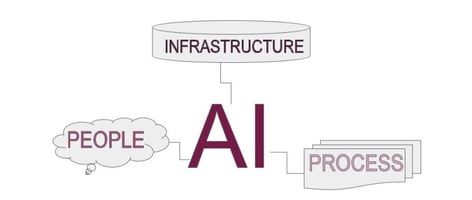There’s almost always a competitor for your product, business or brand. It doesn’t matter how...
The Data Matrix: It’s not enough to be capable, you also have to be ready
A few years ago, when I was just starting to build out a newly formed analytics team at the company where I was working, I was very much focused on data maturity. I even wrote this article (Is your Data Analyst-Friendly?) at the time, long before I started on this weekly blog article thing. What I learned from my very smart team in the years that followed is that Data Maturity is only half of the story. There’s this whole other dimension to the problem: Analytical Readiness.

Just so we’re on the same page, by “data maturity” I mean the availability, quality, accessibility, and usability of the data itself. “Data immature” organizations have major gaps in their data, unreliable data points, clunky or non-existent systems for fetching the data and limited access across the organization. While “Data mature” organizations have high-quality systems designed to get data in the right form to the right person at the right time to make the right decisions.
On the other hand, “analytical readiness” refers to the human factor, specifically does the organization know how to use the information that is available to it? “Analytically Unprepared” organizations may have easy access to high-quality data at their fingertips, but the business end-users don’t know what questions to ask or what form they need the data in to make decisions. “Analytically Ready” organizations, conversely, recognize data as a fundamental element of their strategy and have built data and analytical tools to help them achieve strategic goals.
The diagram above is a typical matrix view that lays out the different combinations described below:
AD HOC (Low Data Maturity/Low Analytical Readiness)
- These organizations have data that is inaccurate, low quality and lacking a clear and thoughtful architecture.
- Accessing data is clumsy and difficult, often requiring requests to data engineers or other IT professionals.
- The data is often shared with business end-users as data dumps, many times in the form of spreadsheets. This leads to frustration and, frequently, to “giving up” on using data to drive decision making because it is just too hard.
- Data is treated as an IT function with major gaps between how data is structured/shared and what the end-user actually needs. This is often driven by a lack of communication between end-users and data professionals who don’t understand each others’ functions.
- Senior leaders are often unaware of the nature and depth of data challenges. They lack understanding and knowledge to come up with a solution. They just know that something is wrong and end up blaming the unfortunate business analysts at the end of the line for problems that go far beyond their scope.
The remedy in this quadrant is to a deep dive into the root causes and underlying issues. There needs to be an influential leader in the organization who can clarify the challenges for senior leadership, providing a vision for improving and championing the cause. Dedicated resources are needed to fix the problem, most likely from outside the organization as internal teams will never have seen “it done right” before.
READY (Low Data Maturity, High Analytical Readiness)
- These organizations have recognized the challenges they have in using data to drive decision making and are committed to fixing the root causes.
- They understand what the end-state needs to look like, i.e. analytical tools that get information in the hands of decision makers when they need it. However, they acknowledge that it may take some time to get to that ideal because of the underlying challenges with data quality, structure and architecture.
- They have built a clear multi-year roadmap for how they plan to improve the current situation in terms of functional capabilities, data/analytical tools and change management for data professionals and business end-users.
- There is clear alignment around the investment in both talent and dollars to achieve the roadmap because there is agreement on the value of the desired end state.
- They are focused on getting the underlying data structures right rather than on “shiny penny” fads and hype cycles in the data/AI space.
Companies in this quadrant are ready to accelerate their data/analytical capabilities. They can move more quickly and benefit significantly from building a strong team as well as bringing in 3rd party support to help rapidly stand-up the future state.
RESISTANT (High Data Maturity, Low Analytical Readiness)
- Companies in this group have high data quality and highly-skilled data teams. There are, likely, distinct functions for data engineering, analytics, and potentially even data science.
- Data and analytical professionals in these organizations may even be focused on end-users and designing tools for their needs.
- However, the business “end-users” in these organizations do not value data, preferring to make decisions using legacy methods or by “gut.” They are resistant to change and view the use of data as unnecessary or even threatening to their livelihood.
- Senior leadership does not want to invest the time to understand how decisions are made and whether decisions could be improved by the use of analytical tools.
- When data is requested, it is done on an ad hoc basis often via unclear and unstructured requests that are difficult to comply with. This leads to a vicious cycle where requesters feel that data and analysis are a “waste of time.”
- Data and analytics professionals are demoralized because they feel their work is not appreciated, and they can easily see the potential for more data impact if only the organization would let them do the work.
These organizations need a strong leader who can describe the potential and impact of analytics to senior leadership. Investment in change management will be required in order to get associates on-board with using data at every level of the company.
INNOVATIVE (High Data Maturity, High Analytical Maturity)
- High-quality data is fed into well-designed, easily accessible analytical tools that business end-users have at their fingertips.
- Descriptive and diagnostic analysis are done almost automatically or can be accessed by anyone who needs the information with minimal training.
- There are distinct, highly-skilled teams for data engineering, analytics and data science with clear roles, defined goals and a mandate for continuous improvement.
- There is a focus on using cutting data science edge tools, like machine learning and generative AI, with defined governance, testing protocols and controls.
- There is a broad scale understanding of the value of analytics across all functions of the organization. Associates are expected to have an appropriate level of data and analytical literacy so that they can make better data-driven decisions.
- Data and analytics are viewed as a strategic capability and are included within strategic roadmaps across the organization. At the highest levels, this includes using analytics to track KPIs, predict challenges and prescribe recommended actions.
These organizations are poised to or are already leveraging data and analytics as a competitive advantage. The focus should be on exploring new ways to use analytics to drive strategic goals across the business.
Understanding where an organization is on this matrix is essential to defining the path to growth and progress. Each quadrant requires a different approach.
If you are interested in discussing further or need a partner to help assess where your organization is today and how to move forward, shoot me a note at jeff.sigel@proprioceptive.io.



